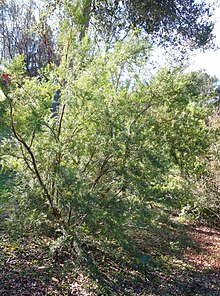
Taxus is a genus of coniferous trees or shrubs known as yews in the family Taxaceae. Yews occur around the globe in temperate zones of the northern hemisphere, northernmost in Norway and southernmost in the South Celebes. Some populations exist in tropical highlands.
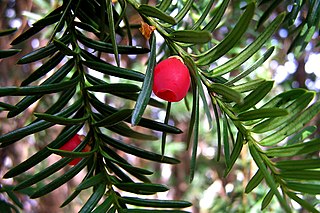
Taxaceae, commonly called the yew family, is a coniferous family which includes six extant and two extinct genera, and about 30 species of plants, or in older interpretations three genera and 7 to 12 species.

Taxus baccata is a species of evergreen tree in the family Taxaceae, native to Western Europe, Central Europe and Southern Europe, Northwest Africa, northern Iran, and Southwest Asia. It is the tree originally known as yew, though with other related trees becoming known, it may be referred to as the common yew, English yew, or European yew. It is primarily grown as an ornamental. Most parts of the plant are poisonous, with toxins that can be absorbed through inhalation and through the skin; consumption of even a small amount of the foliage can result in death.
Pseudotaxus chienii, the whiteberry yew, is a species of plant in the yew family, Taxaceae. It is the sole species in the genus Pseudotaxus, but closely related to the other yews in the genus Taxus. It is endemic to southern China, occurring in northern Guangdong, northern Guangxi, Hunan, Southwest Jiangxi and southern Zhejiang.

Taxus cuspidata, the Japanese yew or spreading yew, is a member of the genus Taxus, native to Japan, Korea, northeast China and the extreme southeast of Russia.
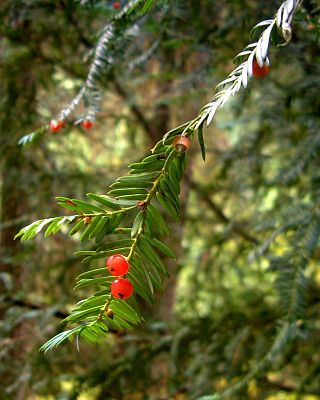
Taxus brevifolia, the Pacific yew or western yew, is a species of tree in the yew family Taxaceae native to the Pacific Northwest of North America. It is a small evergreen conifer, thriving in moisture and otherwise tending to take the form of a shrub.
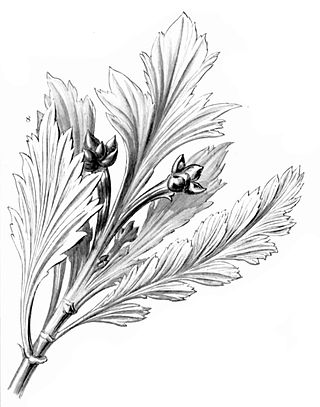
Phyllocladus aspleniifolius, commonly known as the celerytop pine, is an endemic gymnosperm of Tasmania, Australia. It is widespread and common in Tasmania, with the most abundance in the western highlands. Its ‘leaves’ appear similar to those of a celery plant, hence the common name.

Taxus canadensis, the Canada yew or Canadian yew, is a conifer native to central and eastern North America, thriving in swampy woods, ravines, riverbanks and on lake shores. Locally called simply "yew", this species is also referred to as American yew or ground-hemlock.
Taxus celebica is a large, evergreen shrub or tree of the yew family (Taxaceae), widespread in China at elevations up to 900 meters. It is commonly called Chinese yew though the term also refers to the Taxus chinensis or Taxus sumatrana.

Taxus wallichiana, the Himalayan yew, is a species of yew, native to the Himalaya and parts of south-east Asia. The species has a variety of uses in traditional medicine. It is currently classified as endangered by the IUCN.

Taxus chinensis is a species of yew. It is commonly called the Chinese yew, though this term also refers to Taxus celebica or Taxus sumatrana.

Taxus floridana, the Florida yew, is a species of yew, endemic to a small area of under 10 km² on the eastern side of the Apalachicola River in mesophytic forests of northern Florida at altitudes of 15–40 m. It is listed as critically endangered. It is protected in reserves at the Torreya State Park and at the Nature Conservancy's Apalachicola Bluffs and Ravines Preserve, and has legal protection under the United States and Florida Endangered Species laws.

Taxus globosa, the Mexican yew, is an evergreen shrub and one of the eight species of yew. The Mexican yew is a rare species, only known to be found in a small number of locations in eastern Mexico, Guatemala, El Salvador and Honduras, and is listed as an endangered species. The Mexican yew is a shrub that grows to an average height of 4.6m. It has large, sharp light green needles growing in ranks on either side of its branches.

Tsuga chinensis, commonly referred to as the Taiwan or Chinese hemlock, or in Chinese as tieshan, is a coniferous tree species native to China, Taiwan, Tibet and Vietnam. The tree is quite variable and has many recognised varieties, though some are also maintained to be separate species by certain authorities. The tree was recently discovered in the mountains of northern Vietnam, making that the southernmost extension of its range.

Leucopogon parviflorus, commonly known as coast beard-heath or native currant, is a shrub or small tree in the family Ericaceae. It is native to all Australian states and territories excluding the Northern Territory and the ACT and also grows in New Zealand. The species can grow to between 1 and 5 metres in height and has leaves that are 11 to 29 mm long and 2.4 to 7.5 mm in width, often with curved tips. The white flowers are around 15 mm long and are produced in spikes of 7 to 13. These occur throughout the year.

Eucalyptus cephalocarpa, commonly known as mealy stringybark or silver stringybark is a species of small to medium-sized tree, that is endemic to south-eastern Australia. It has rough, fibrous bark on the trunk and branches, lance-shaped adult leaves, Flower buds arranged in groups of seven, white flowers and conical, bell-shaped or hemispherical fruit.

Hakea chordophylla, commonly known as bootlace oak, bootlace tree, corkwood, or bull oak, is a species of shrub or small tree in the family Proteaceae found in central and northern Australia. Bears very showy golden yellow, pale green or cream nectar rich flowers in winter.
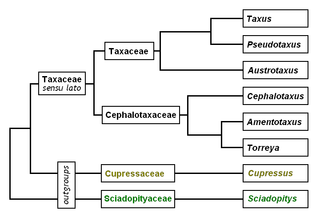
Yew is a common name given to various species of trees.

Taxus × media, sometimes known simply as Taxus media, is a conifer created by the hybridization of English yew Taxus baccata and Japanese yew Taxus cuspidata. This hybridization is thought to have been performed by the Massachusetts-based horticulturalist T.D. Hatfield in the early 1900s.

Kunzea serotina, commonly known by its Māori name makahikatoa, is a flowering tree or shrub of the family Myrtaceae in the genus Kunzea, found in both North Island and South Island of New Zealand.
